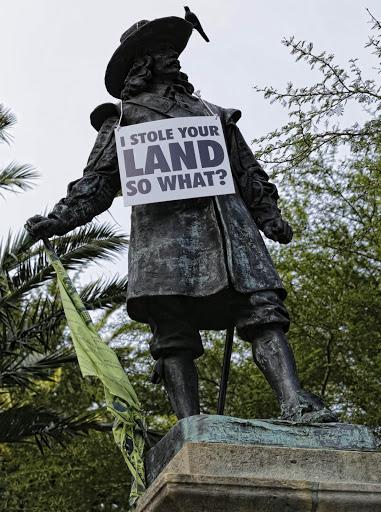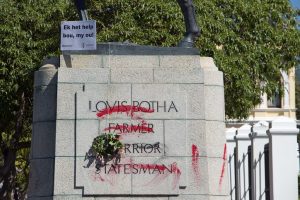
Beloved and hated, what does the future hold for Jan van Riebeeck’s statue in Cape Town, South Africa?
Mini Assignment 1, course Researching Africa in the 21st Century, September 2023
By Laura Eppinga and Frederike Bonekamp
Even though apartheid was abolished in 1994, colonisation and apartheid remain visible in South African society. Colonial figures, such as Jan van Riebeeck, are represented in the physical space in the shape of statues, schools, and street names. Statues of colonial figures are seen as an adoration of colonialism, as they symbolise a particular person, time, or event, commonly to heroise a person. Protestors are arguing for removing these statues to decolonise public space and make society aware of the atrocities these figures have committed. Many of these protests go as far as demolishing, defacing, or destroying the statues.[1] However, another part of society, mainly Afrikaner groups, feels that the removal of ‘their’ statues is an attack on their heritage. What does this complicated debate truly say about apartheid, colonialism, and its legacies in South Africa?
One mentionable statue in this debate is that of Jan van Riebeeck, known as the founder of the ‘Boer Nation’. He was the first white Dutch settler who touched down in Cape Town in 1652 on behalf of the Dutch East India Company. He was not sent to Table Bay to establish a colony; however, van Riebeeck argued that free “burghers” needed to own farms surrounding the fort.[2] As a result, the Khoikhoi and the San people, together with their cattle herds, were driven out of the land, creating a Dutch colony. To date, Jan van Riebeeck’s statue has been located in Cape Town on Heerengracht Street since Cecil Rhodes gifted the statue to the city in 1899.[3]
Given that van Riebeeck is known as the first white settler in South Africa, his statue has been part of the debate about removing colonial statues to decolonise public space. This debate reaches many parts of the society and contains diverse perspectives. For example, in the academic debate, Landman argues that decolonisation in the public space is necessary, whereby removing symbols of oppression is a crucial step.[4] Other scholars argue that removing statues should be carefully considered, as it may not lead to critical insights.[5] Removing these statues can hide histories, discouraging South African society’s decolonisation.[6] Some scholars focus on South African cultural heritage. Drayton argues that South African heritage may need to be renegotiated to include the parts of history that have been hidden.[7] Moreover, Fubah argues that an increased number of statues honouring anti-colonial people can reshape the cultural landscape while pushing forward new “cultural representations”.[8] However, Marschall argues that cultural heritage, including statues, can only lead to social cohesion when the interaction between the memory of the past, socio-economic inequality, and the legacies of apartheid is addressed.[9]
https://www.newsflare.com/video/434957/give-colonial-statue-to-politician-who-endorsed-colonialism-says-south-african-traditional-leader?origin=arendse
In contrast to the academic debate, the public debate about removing colonial statues, such as the one of Jan van Riebeeck, is more personal, as people regard the issue as an essential part of life that influences their heritage and identity. It becomes clear that citizens mainly focus on whether controversial statues should be removed and who can do so. The two videos show two sides of the debate; on the one side, the Afrikaner groups are against removing and vandalising the statues, and on the other side, Khoi Chief Melvin Arendse, who is in favour of removing the colonial statues. In general, groups against the statue’s removal, mostly activist Afrikaner groups, feel excluded from the statue discussion and experience Afrikaners being portrayed as land thieves, for which they blame Jacob Zuma because he supports anti-statue demonstrations.[10][11][12] They often mention the importance of heritage and argue that the vandalisation of the statue is an attack on Afrikaners.[13]
Arguments in favour of removing colonial statues suggest that statues are not just colonial symbols; they possess power and should be taken down when glorifying oppression, as these statues undermine an honest view of history.[14][15] Khoi chief Melvin Arendse argues for the removal of the statue of Jan van Riebeeck and to gift it to politicians that endorse colonialism, such as Helen Zille, who in 2017 tweeted about the benefits of colonialism. He furthermore emphasises that the Khoi people ‘own this land’.[16] Calls for more radical reforms of the public space explain that the heated statue discussion highlights the need for fundamental transformation.[17] Mbuyseni Ndlozi, the spokesman of the Economic Freedom Fighters, sees the need for new statues to remember the colonial- and apartheid past, not limited to icons of colonialism, which represent freedom fighters and others who opposed colonialism.[18]
Although, some people argue for a more carefully considered look at the statues. For example, The Minister of Arts and Culture wants statues to be examined individually and preserved in museums if necessary.[19] Besides that, The South African Heritage Association allows multiple interpretations of controversial statues and accepts their historical ties to colonialism to not forget history.[20]

Louis Botha’s statue in Cape Town was honoured with wreaths by members of the AfriForum after it was vandalised during anti-statue protests (Afrikaner group) (HelenOnline, 2015).
Thus, the debate about controversial statues in South Africa’s public space reaches many groups who are divided about the issue, leading to an uncertain future of controversial statues in South Africa’s public space. The discussion about removing van Riebeeck’s statue demonstrates perfectly how controversial historical figures relate to the ongoing decolonisation of public space. When looking at the debate, we see the need for new ways to represent and include these figures in public space, as these statues represent incomplete history to a large part of society. In our opinion, it is essential to carefully evaluate each statue to prevent the removal of all controversial statues, which is not preferable because this erases uncomfortable history and creates tensions within society. Given this, we think these statues should be preserved in museums, where there is room for honest conversations about the real history behind these statues, for all opinions to be heard, and for the truth to be explored. Including these statues in the public space of Cape Town may provide the risk of wrongful heroism due to the lack of understanding of the person’s historical actions.
In that case, the Minister of Arts and Culture’s approach when dealing with controversial statues, which is to evaluate them individually and preserve them in museums if necessary, to not exclude people or erase history, can be pretty valuable. We think the government plays a vital role because the anti-statue discussion shows that the colonial and apartheid past is still visible in society, manifesting itself through economic inequality and racism. The debate about controversial statues will not be solved if the legacies of apartheid and colonialism are not acknowledged and effectively addressed. Nevertheless, the question remains: will removing colonial statues create the much-needed decolonisation of South Africa’s public space, or will it just downplay the past and create a highly divided society?
Sources
[1] Christiana Abraham, “Toppled Monuments and Black Lives Matter: Race, Gender, and Decolonization in the Public Space. An Interview with Charmaine A. Nelson”, Atlantis 42, no 1 (2021): 4.
[2] Jochen Petzold, “In Search of a New National History: Debunking Old Heroes in Robert Kirby’s The Secret Letters of Jan van Riebeeck,” Research in African Literatures 32, no. 3 (2001): 145.
[3] Ciraj Rassool, and Leslie Witz, “THE 1952 JAN VAN RIEBEECK TERCENTENARY FESTIVAL: CONSTRUCTING AND CONTESTING PUBLIC NATIONAL HISTORY IN SOUTH AFRICA,” Journal of African History 34, no. 3 (1993): 451.
[4] Karina Landman, and Kundani Makakavhule, “Decolonizing Public Space in South Africa: from conceptualization to actualization,” Journal of urban design 25, no. 5 (2021): 553.
[5] B. Schmahmann, “Public Art And/as Curricula: Seeking a New Role for Monuments Associated with Oppression,” in Decolonisation in Universities: The Politics of Knowledge, edited by D. J. Jansen (Johannesburg: WITS University Press, 2019), 187.
[6] A. Goodrich, and P. Bombardella, “What are statues good for? Winning the battle or losing the battleground?” KOERS – Bulletin for Christian Scholarship 81, no. 3 (2016): 8.
[7] Richard Drayton, “Rhodes Must Not Fall?: Statues, Postcolonial ‘Heritage’ and Temporality,” Third
text 33, no. 4-5 (2019): 665.
[8] Mathias Alubafi Fubah, “The changing nature of statues and monuments in Tshwane (Pretoria) South Africa,” Ethnography 21, no. 4 (2020): 456.
[9] Sabine Marschall, “The long shadow of apartheid: a critical assessment of heritage transformation in South Africa 25 years on,” International journal of heritage studies 25, no. 10 (2019): 1089.
[10] Alana Bailey, “Zuma ultimately responsible for defacing of statues – AfriForum,” Politicsweb, April 13, 2015, https://www.politicsweb.co.za/politics/zuma-ultimately-responsible-for-defacing-of-statue.
[11] Natalie Malgas, “Afrikaner groups protest near Jan van Riebeeck statue,” Eyewitness news, April 8, 2015, https://ewn.co.za/2015/04/08/Group-protests-against-Jan-van-Riebeeck-statues-removal
[12] David Smith, “Vandalism of apartheid-era statues sparks fevered debate in South Africa,” The Guardian, April 10, 2015, https://www.theguardian.com/world/2015/apr/10/vandalism-of-apartheid-era-statues-sparks-fevered-debate-in-south-africa.
[13] PMB Video Archive, “Afrikaner groups wade into statue debate,” PMB Video Archive, September 1, 2019, News Video, 1:49, https://www.youtube.com/watch?v=UkfGp4eT7uw.
[14] Yusuf Lalkhen, Shabodien Roomanyay, and David Ritchie, “City’s statues: If Rhodes must fall, van Riebeeck must also fall,” Cape Argus, June 24, 2020,
https://www.pressreader.com/south-africa/cape-argus/20200624/281509343447209.
[15] Mail & Guardian, “We must show that we defeated apartheid,” Mail & Guardian, April 8, 2015, https://mg.co.za/article/2015-04-08-we-must-show-that-we-defeated-apartheid/.
[16] Wesley Fester, “Give Colonial Statue to politician who endorsed colonialism says South African leader,” Newsflare, June 16, 2021, News Video, 2:19, https://www.newsflare.com/video/434957/give-colonial-statue-to-politician-who-endorsed-colonialism-says-south-african-traditional-leader?origin=arendse.
[17] Greg Nicolson, “Op-Ed: Statues of thought and symbols of resistance,” Daily Maverick, April 9, 2015, https://www.dailymaverick.co.za/article/2015-04-09-op-ed-statues-of-thought-and-symbols-of-resistance/.
[18] BBC News, “Cape Town University votes for removal of colonial statue,” BBC news, April 9, 2015, https://www.bbc.com/news/world-africa-32222776.
[19] Smith, “Vandalism of apartheid-era.”
[20] Goodrich, “What are statues”
Leave a comment
You must be logged in to post a comment.